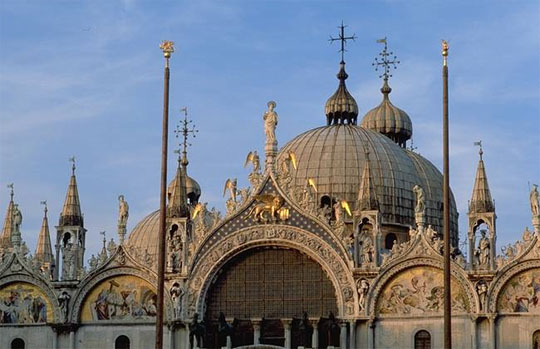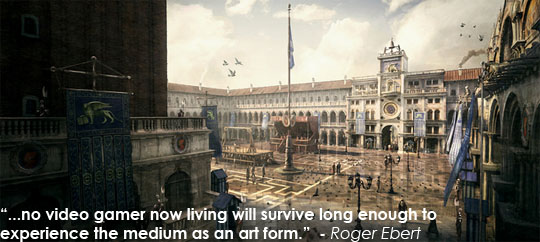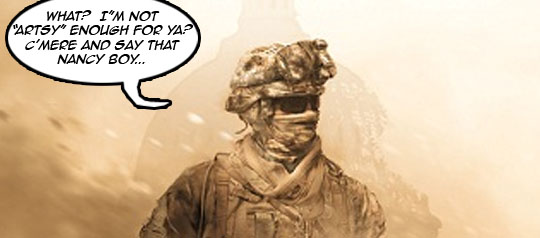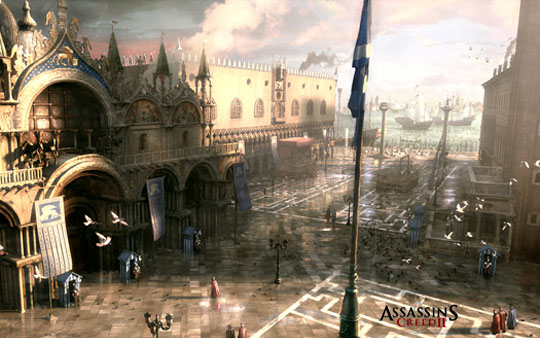Video games can’t be art? Why Ebert is wrong and should gamers care?
Back in 2005, famed film critic Roger Ebert posited that ‘video games can be elegant, subtle, sophisticated, challenging and visually wonderful”, but “the nature of the medium prevents it from moving beyond craftsmanship to the stature of art’, or, as many online at the time boiled it down, ‘Roger Ebert hates video games’. Numerous video game fans replied to that column, and to this day I’ve seen references to his ‘hatred’ crop up from time to time. This is usually when he pans a movie that a gamer liked, with the rebuff akin to ‘Ebert just doesn’t get it’. Though I don’t always agree with Ebert, I think he’s a fine critic, but he’s never missed the mark so much as he did in that 2005 column.
He really hasn’t expanded too much on this though, until last Friday, when he said, amongst other things, “…no video gamer now living will survive long enough to experience the medium as an art form”. He wrote this after being convinced by a reader to check out a 2009 TED X presentation by Kellee Santiago, who challenged his original quote with the statement “Stop the debate. Games are art” at the beginning of the presentation. She then offers up some interesting choices to prove her point. Some I may not agree with, and this is what a large part of the debate hinges on.
I don’t think either side is entirely right, and anybody who is a gamer, or game developer would probably agree…
I disagree with Ms. Santiago’s statement that ALL video games are art, or at least aspire for that lofty goal. I also feel this way about movies, books and just about any other medium, including that most arty of arts, painting. Does Transformers 2 even register on the same scale as Goodfellas, or 8 1/2? Is the guy who’s commissioned to paint blue and pink pastel forms on a canvas so it will match the dentist office it will decorate in 1983 worried about how it will be interpreted, or just that the colours match? So saying “Video games are art” is like saying that “Painting is art” or “Architecture is art”. That’s just wrong. I’d be happier if she said “Video games CAN BE art”. That isn’t to say that she doesn’t raise some good points, which you can catch in the following presentation (15 min)…
While at the same time, in last week’s column, Ebert raises an interesting question…
Why are gamers so intensely concerned, anyway, that games be defined as art? Bobby Fischer, Michael Jordan and Dick Butkus never said they thought their games were an art form. Nor did Shi Hua Chen, winner of the $500,000 World Series of Mah Jong in 2009. Why aren’t gamers content to play their games and simply enjoy themselves?
In every single game mentioned above, the players (and viewers), derive their emotional responses purely from the process of competition, and its ultimate outcome. And you know what? Some video games are like that. Any competitive multiplayer game like Team Fortress 2, gives the exact same competitive rush, and it’s all about ‘beating’ the other team. That’s why games like TF2 and Call Of Duty have such rabid multiplayer fan bases.
The quality of the textures and rendering (outside of those that affect gameplay) are as superfluous as the quality of the designs on a Mah Jong tile or the detail put into the carvings on the chess pieces. That doesn’t mean they’re not appreciated, and there is artistry in the design. Some would call it craftsmanship (including, I guess, Ebert) but I’d call it art. At the same time, it’s just not the reason for the experience.
This could be seen as a point in Ebert’s favour…
Even though I loved Braid (one of Ms. Santiago’s examples) for its visual design, I think an argument could be made that if stripped of it’s unique audio and visual artistry, the gameplay mechanics still make it a fascinating puzzler, and one of the most inventive to come out in a long time. That’s pure speculation on my part, and I don’t mean to take away from the gorgeous atmosphere of the game, because it really is very beautiful. The visuals of the game are a real part of the experience, at least for me. I can see how someone who’s most known for his critique of the film medium might not find it compelling, and would possibly consider it really good set design, but nothing more.
This is why I think Ms. Santiago’s examples fall flat. Though I won’t pretend to try and define art, one of the key components of judging the artistry of something, especially in the context of a storytelling medium, is the emotional response it evokes from the viewer/listener/player.
When I say emotional response in games, I mean beyond the base responses of joy or anger that are elicited when the player does something well or poorly, respectively. You know what I mean by base responses… who HASN’T wanted to throw their controller through the television screen at some point? I’m talking about responses to the story that unfolds as you play the game.
Let’s take the game Mass Effect 2 for example (I know, I know, I’m biased). When you start the game you take on the role of a character, and your decisions throughout it affect the kind of story your going to get, and how other characters are going to react to you.
As you and your crew reach the climax of the story, you have to make choices that increasingly put yourself and them at risk. Decisions that you know will be life threatening, and in some cases are. The loss of a crew member doesn’t affect the mechanics of the game (beyond that character not being in the sequel). There is a real emotional response though, just one has a real emotional response to a novel, film or any other type of storytelling art form. The only real difference being that, in some cases, the emotional response to a storytelling element is not just a reaction to what the author has written, but based on your own decisions.
Another component of ‘art’ is generally something that inspires. I won’t go so long in this one, but I will say that after playing through Assassins Creed II, I’ve been more inspired to see the architecture of numerous Italian cities than I was from any Fellini film, or art history class. In fact, other than possibly Ken Follett’s book “The Pillars Of The Earth”, Assassins Creed II has done more to impart an interest in architecture to me, outside of actually visiting a great building. Certainly, I’d argue that AC II is probably the best way to convey the beauty and majesty of the Basilica di San Marco, because not only do you get to climb all over it an other historically significant Italian buildings, but it lead me to spend hours just reading about the real life counterparts (which are certainly faithfully represents, as well). It was the artistry of the whole Assassins Creed II team that created that inspiration.
Is the above image art? Just a simulacrum? Beyond the building that it represents, does it have more or less artistic merit, in its own existence, than the below photograph of the same structure?

Does art require effort? If so, how much? Since photography is so easy in the digital age, does it make photography any less valid than when one had to spend time in a darkroom developing film? When you can take 100s of pictures a day, and sift through them looking for one with interesting enough composition and lighting that knowledgeable critics would see the ‘art’ in it, are you an artist, or a collector of happy accidents?* I guess you get the point though.
I think what really stuck me with Ebert’s latest column was the ‘cheap shot’ manner in which he ended it…
I allow Sangtiago the last word. Toward the end of her presentation, she shows a visual with six circles, which represent, I gather, the components now forming for her brave new world of video games as art. The circles are labeled: Development, Finance, Publishing, Marketing, Education, and Executive Management. I rest my case.
And Robert Altman rested his case for damning the film industry with The Player, yet movies made within the Hollywood system (which very much is exemplified by said ‘six circles’ – minus education) can still garner 4 star reviews and the label of art. I guess art, like life, finds a way. While art may be the furthest thing from my mind when I’m building a turret in the intelligence room while playing Team Fortress 2, there’s plenty enough examples in the video game world to show where Ebert is wrong. Of course, the games I personally chose ARE a matter of opinion, but every gamer probably has their own list.
I can’t help but think that this whole debate has the same ring of generational verisimilitude between parents and their kids arguing about whether rock and roll is art or noise. I too will probably find myself sitting on a hover-porch telling kids to get off my damned lawn with their anti-grav shoes leaving radiation burns in the fresh cut grass with their squelches that pass for music blaring too loud.
Or maybe I’ll just go inside and play a video game, because with that hole in the ozone as far south as James Bay, one wouldn’t want too much sunlight. That could kill you.
*No photographers feelings were meant to be hurt by this article.








Doesn’t look like everyone defines art the same way, from wikipedia:
“Art is the process or product of deliberately arranging elements in a way to affect the senses or emotions. It encompasses a diverse range of human activities, creations, and modes of expression, including music, literature, film, sculpture, and paintings. The meaning of art is explored in a branch of philosophy known as aesthetics.”
Maybe Ebert just doesn’t want to admit he (the greatest film critic to ever walk the earth) is wrong.
I’m not sure Santiago describes very well either. She depicts a cave drawing and then compares it to the sistine chapel, saying the latter is the ART that grew out of the crude meaningless scratchings of the former. While that’s true, all periods have been begotten of a former one, and Santiago’s example simply points out what she considers to be GOOD art.
I also think Ebert’s Gamers line is more of an eff-you than the ending:
Why aren’t gamers content to play their games and simply enjoy themselves?
Because all other forms of fictional media are considered art and this one isn’t. That’s pretty basic to me. Why is Ebert never content with being told a story? Why does he have to pick apart every movie he sees and rate it based on his arbitrary scale, which he, clearly, feels is one that is used to judge the artistic value of a movie?
Irritating.
I’m not going to Wiki a definition of Art because I don;t really think there is one. The closest thing I can come up with is along the lines of saying, Art is making something from whence there was nothing, or maybe, arranging meaningless things into something meaningful. To me Art applies to any craft, from writing to carpentry to needlepoint to electronics design to painting to cooking to landscaping and so on.
Shit I do it for a living and I have NO idea what it is. Though I’m sure that you’ll happily argue whether what I do qualifies as “art” (even though it totally does :P)
I agree. The real question is whether a particular game is art. Anyone who says that games, as a medium CANNOT be art is just an idiot. 🙂
BTW, Cracked, of all places, has a REALLY good rebuttal…
http://www.cracked.com/blog/why-ebert-is-wrong-in-defense-of-games-as-art
Particularly, this section on REZ alone is worth the read, and I’ll post it…
Though I disagree with them about how much fun it is to play… I loved every second of it.
Okay Doug, call me an idiot, but,..
I believe there are two types of art. There is Art, like a Van Gogh painting which is something created by an individual as a means of self-expression, and there is commercial art, like a movie, an ad, a cereal box, or a video game. Something created by committee to generate income. Commercial art involves a great degree of skill and craft, but lacks the soul of big A art.
As the most successful segment of the entertainment industry, video games don’t really need to qualify as art anyway. Isn’t it enough that they get all our money, while covertly training and recruiting our best and brightest for use as alien starfighter pilots?
I agree with what you’re saying, though I think that some games have been able to pull that off. For the sake of the act of creation, games are much like film, because of the massive undertaking required to make them (especially for the ‘big’ titles). I’d also say that ‘Art’ isn’t necessarily the goal of a significant portion of them.
My main point of contention is that saying that games as a whole can not be art is as ridiculous as saying film can’t be art. Some are, some aren’t, many don’t even try.
Of course, we have the time to talk about this because the alien invasion hasn’t hit yet. : )